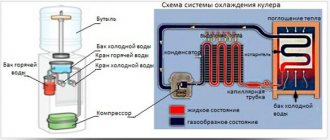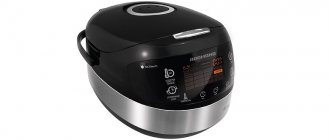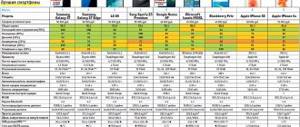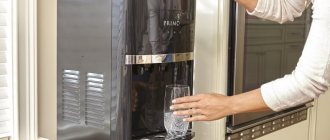How does a water cooler work and what does it consist of?
The dispenser consists of a body, at the bottom or at the top of which a large bottle is placed. In the photo of how the water cooler is built inside, you can see a simple distribution system and tanks. The latter are usually present in quantities of two pieces, for cold and hot liquids.
Water from the bottle enters the internal tank, designed for cooling, and then through the connecting pipe enters the boiling water container. Depending on the user's needs, the cooler cools or heats the liquid in the selected reservoir. Mixing of hot and cold water does not occur thanks to a check valve that balances the pressure of the system.
- Most often, devices are equipped with two taps for boiling water and chilled liquid.
- In some models there is only one output and resembles a joystick or a regular mixer.
- There are also devices with three taps; such devices supply hot, chilled and moderately cool water.
- Premium devices can be equipped with a liquid carbonation unit.
Regardless of the water supply options, the design of the dispensers is approximately the same.
Floor-standing and tabletop coolers are almost the same on the inside, the latter are simply more compact.
Design and electrical circuit of a desktop water cooler
Tabletop dispensers are the most popular at home. They are small in size, do not take up much space, and can be installed in the kitchen on a cabinet or table. As a rule, such devices work with bottles with a volume of 5-11 liters.
The electrical circuit of the desktop cooler includes a short circuit fuse
The diagram describing the design of a tabletop water cooler is standard; it differs little from the design of floor-standing models. From a bottle placed on top of the device, the liquid flows first into the “cold” and then into the “hot” dispenser reservoir. From time to time, the unit automatically starts active operation and cools or heats the contents of the compartments to maintain the desired temperature.
When the user presses a button or lever, water from a specific reservoir flows into the cup. Then the supply stops, and the outlet of the device is blocked with a special blocker.
Water cooler with refrigerator
Some coolers are equipped with a refrigerator; it can be placed at the bottom of the device. For obvious reasons, only floor-standing models support this function; desktop dispensers do not have room for an additional chamber.
Since the refrigerator compartment is located at the bottom of the unit, the bottle can only be placed on top
The operating principle of the dispenser is very simple. The same compressor is responsible for the functioning of the cooler itself and the refrigerator. It maintains approximately the same temperature in the lower chamber and in the cold liquid container. It is not possible to configure individual parameters for different parts of the unit.
A cooler refrigerator differs from a standard one not only in size, but also in temperature. Conditions around 7-12 °C are constantly maintained inside the chamber; products that do not require real freezing can be stored in it. It is impossible to provide the latter for the dispenser due to the fact that when the compressor switches to a new mode, the cold water in the upper part of the device will freeze.
Bottom loading water cooler device
In some devices, the bottle is located not on top, but in the lower cabinet. This water cooler design is especially popular among physically weak people who simply cannot lift a heavy and large tank to a height. In addition, the bottle located below cannot fall and damage the unit, this is also a plus.
The water container in bottom-loading dispensers is connected to the main part by a pipe
The operating principle of such coolers remains standard. The only difference is that water is supplied from the bottle to the internal compartments using an electric pump. Then it is distributed in the usual way from the “cold” reservoir to the “hot” one, and the dispenser heats or cools it automatically.
Purifiers
In the 90s Since the last century, machines have appeared equipped with a built-in water purification system from the water supply system. Compared to coolers, a significant advantage has appeared - cost savings while maintaining the good taste properties of the liquid.
- There was no longer any need for colossal expenses on the purchase and delivery of bottles.
- The purity, freshness, and taste of water no longer depend on the conditions of production, storage and delivery. Cleaning occurs immediately before use.
- The devices of new times were called “purifier”, i.e. “purifier”, if you translate the word from English.
At first, purifiers in which water was purified using reverse osmosis technology became widespread. Only H2O molecules remained in the water, and all foreign substances were removed.
Nowadays, a new European trend is increasingly being used - drinking water dispensers equipped with an innovative filtration system. Such devices are also called flow coolers. Their peculiarity is that they retain beneficial minerals and salt in the liquid, and various contaminants are effectively removed.
Russia is adopting the experience of Western countries in the field of supplying offices with high-quality drinking water. In 1993, the first bottled water coolers appeared. In 1999, machines capable of filtering drinking water were installed everywhere. Nowadays there is a large selection of devices on the market, so many users find it difficult to understand their names and differences.
Working principle of a water cooler
Most devices support two operating schemes at once - cooling and heating. In both cases, built-in electronics are responsible for adjusting the temperature of the liquid.
The principle of cooling water in a cooler
There are two types of liquid cooling in the dispenser:
- Compressor. The device operates on the principle of a refrigerator. First, the refrigerant in the form of an aerosol enters the condenser, cools and turns into a liquid state, and then seeps through the capillaries into the evaporator. There, the pressure drops and the substance boils, absorbing heat as it turns into steam.
- Electronic. Such dispensers operate according to the Peltier system - electric current flows through a chain of several conductors, and the connection points are cooled, and at the same time the water temperature decreases.
Important! The electronic circuit is considered more reliable and environmentally friendly. However, compressor cooling is faster.
The principle of heating water in a cooler
The operating principle of a water cooler with a heating function is similar to that of an electric kettle. First, the liquid is pumped from the main container into a special reserve container. There is always water in this compartment; when it is empty, the unit refills it automatically.
Next, the tubular element is activated and the heating process occurs. Dispensers do not bring the liquid to a boil, but stop at a temperature of about 98 degrees. In this case, water retains its taste and maximum benefits. The heating element can be located both inside the corresponding container and outside it, depending on the model.
Best Tabletop Water Coolers
Unlike floor-standing models, such devices are intended exclusively for installation on a table. They are small in size and do not take up much space, so they are often chosen for home use. These devices can both perform the function of heating and cooling, and serve only to distribute water at room temperature. In this case they are called dispensers. Coolers are considered in this rating category.
Aqua Work 0.7-TD
This is the most versatile cooler in the rating. The place for the bottle is hidden from the eyes of others by the door and is located at the bottom. This makes it easier to change containers. Externally, the device resembles a refrigerator, only it has smaller dimensions: height – 83 cm, width and depth – 40 cm. The device supplies both cold and hot water. For this purpose, there is one tap and a sensor feed.
Aqua Work 0.7-TD is especially convenient for brewing teas and preparing instant coffee. The set includes two matching metal teapots that sit on top. Under the lid there is a small drawer for storing utensils. The set also includes a water storage tank. The device performs two tasks at once - heating at a power of 1350 W and cooling at 70 W.
Advantages
- Ease of Management;
- The water is heated almost to boiling water;
- Does not spoil the taste of the liquid;
- Compactness;
- Fast heating and cooling.
Flaws
- Not a low price;
- If the kettle is not installed, water will not be poured.
Reviews note the ease of electronic control of the water cooler, which even older people can easily understand.
Sonnen TS-03
The compact desktop cooler “Sonnen TS-03” provides hot and cool water around the clock. However, you should not expect strong cooling from it - the minimum temperature is 5 degrees at 70 W. Maximum heating is possible up to 92 degrees at a power of 500 W and is carried out in a matter of minutes. That is, in fact, this model provides boiling water, ready for brewing tea and making instant coffee.
Sonnen TS-03 is made of impact-resistant plastic in white and blue. There are two taps for dispensing liquid - blue (cold) and red (hot). Control is carried out through mechanical valves. An LED indicator on the front of the housing warns you that the water is ready. Particularly pleasing is the speed of its supply - 0.5 liters per hour for boiling water and 5 liters for chilled water. It will be useful in home, school, office, hospital.
Advantages
- Designed for 10 users on average;
- Light weight – 3.1 kg;
- Small dimensions – 390 x 315 x 310 mm;
- High quality heating element;
- Reliable electronics.
Flaws
- There is not enough drinking water holder;
- Not very spacious tank for hot and cold water - 0.5 l.
Before first use, it is recommended to drain about 1 liter of water to clean the storage tank and tube from dust accumulated inside.
Types of water coolers
It is customary to distinguish several types of water dispensers:
- Floor-standing. Free-standing models are usually purchased for offices or institutions; the height of the device can exceed 1.5 m, but their width is usually about 40 cm.
Floor coolers demonstrate the best performance - Tabletop. Such devices are often purchased for home use; their height is less than 80 cm; the units can be placed directly on a table or cabinet.
Tabletop dispensers have low power - Compressor. Dispensers of this type demonstrate high performance and cool more water in a short time than models with an electronic board.
A compressor cooler should be installed in enterprises with high consumption of drinking water - Electronically cooled. Models with a Peltier element are cheaper and more durable.
Electronic coolers are suitable for home use and small offices - Bottom loading. Units of this type are more compact and elegant, and anyone can change the bottle in them.
Using dispensers with a bottom positioned bottle is especially convenient for women
Coolers can be divided into separate categories based on the number of taps or the presence of a gas system. But the operating principle of such models remains unchanged; they operate according to one of the basic schemes.
What are the advantages and disadvantages of floor standing water coolers
The maximum number of possibilities is provided by the floor-mounted version of water coolers. It is believed that a floor cooler is very bulky and takes up a lot of space. However, this opinion is erroneous. In fact, it will look very compact in the office, and its internal cabinet, allowing you to store some things in it, will thereby save space.
When choosing a floor-standing refrigerated water cooler, you need to decide what system it should be equipped with. You need to know that the criterion for preference in the case of an electronic or compressor system is the volume of water that will need to be cooled daily. Typically, the capabilities of a floor cooler with electronics allow you to heat up to 5 liters of water, and cool only 1.5 - 2 liters. A cooler with a compressor cooling system is more productive. It is capable of providing up to three liters of cold water within an hour.
A small difference in the volume of heated water is not so important if the choice is focused on a dispenser for home use. For an office, preference should be given to a floor-mounted cooler with a compressor system.
In addition to being more efficient, floor standing water coolers with refrigerators come with some additional useful features. For example, a carbonation system (and the degree of saturation with carbon dioxide can be different), the ability to filter water, an electronic display for monitoring and adjusting the heating/cooling temperature. Floor coolers have lighting and a convenient nest with built-in glass holders.
You should also pay attention to the presence of not two, but three taps supplying water (hot, cold and room temperature), which can be activated by pressing the mug on the tap. There is also such a useful function as child protection on the hot tap, which blocks the water supply and protects against burns.
Recommended articles on this topic:
- Mechanical water pump: types, care, repair
- Water cooler for the office: types and selection criteria
- How to drink water correctly: nuances and tips
Some versions of floor-mounted water coolers have compartments for dishes, built-in refrigerators, as well as ozonizer cabinets. Ultraviolet light from quartz lamps, used in ozonizer cabinets, disinfects dishes and food. Naturally, these cooler options are more expensive. But in a large office they can be used as a mini-kitchen. After all, we have a refrigerator, a cabinet, and a kettle in one building. In fact, the purchase of such a cooler will not only justify itself, but you will benefit due to the possibility of wide practical use of this device.
Floor coolers also have a relative disadvantage. Loading a large, rather heavy bottle is not easy: it must be lifted, turned upside down, and placed on a funnel. The procedure is quite labor-intensive and requires some effort. In this regard, dispensers in which the container is installed in the lower part of the body are becoming increasingly common. If your office is staffed primarily by women, then a bottom-loading cooler would be the best solution.
When you want to purchase a floor-standing water cooler for your home, sometimes doubt arises: is it necessary to deal with frequent loadings of new bottles (which must be brought, stored somewhere, and then installed). Don’t rush to draw conclusions about the imperfections of floor coolers. Maybe a flow cooler (purifier) equipped with an electronic cooling system is better for you. This device is easily connected to the water supply. It is distinguished by the absence of noise during operation. Its most significant advantage is that you do not need to spend money on buying and delivering water - it is always at hand. All he has to do is filter it for drinking, which the cooler does an excellent job of.
A significant advantage of floor-standing coolers compared to desktop ones is the thoroughness of assembly and reliability in operation. Obviously, it has more positive characteristics than disadvantages. Purchasing a floor cooler for an office solves the problem of water supply for a large number of employees and visitors and allows you to use it as a locker and refrigerator. Thus, you save both money and space in the office.
How to use a water cooler
The instructions for using the water cooler are very simple. Before use, first of all, you need to attach the bottle to the device:
- If the dispenser has a top load, then you need to remove the protective sticker from the cap or just carefully pierce it. Then the bottle is turned over and inserted, neck down, into the appropriate slot. Water will flow into the cooler for several minutes. If the unit is new, then after filling you will need to take a glass and drain approximately 500 ml of liquid from both taps; this is necessary to clean the system.
- With bottom loading, the water cooler connection diagram looks simpler: the container is placed in a cabinet, the water intake hose is connected to the neck and the dispenser is plugged into an outlet. Next, you need to press the power button of the device and close the lower compartment. The unit will fill with water in approximately 20 minutes; another half hour will be required to heat and cool the liquid. Afterwards, the power button can be switched back to an inactive state.
As for the daily use of the dispenser, the procedure depends on the features of the model. Some coolers supply water at the touch of a button on the front or top panel. In budget units, you need to press the edge of the cup onto the tap itself, and after filling, remove the container so that the liquid stops flowing.
Important! In order for the cooler to last longer, it is recommended to completely unplug it from the outlet if it is not used for more than three days.
Do-it-yourself water cooler repair and main malfunctions
Like any equipment, water coolers are prone to breakdowns. Some malfunctions can be corrected independently, without resorting to service assistance.
Cooler dirty
Over time, dirt can accumulate in the dispenser, causing it to stop working. To clean the cooler you need to:
- turn off the unit from the network and remove the water bottle;
- thoroughly rinse the surface of the cooler with regular dishwashing liquid;
- carefully treat the place where the needle is located, over which the bottle is placed;
- wash and rinse the tray;
- Wipe all parts of the cooler dry with a napkin or clean rag.
The main dirt accumulates at the junction of the bottle and the cooler.
Then the dispenser is put back together and some water is drained through the taps to wash away the remaining cleaning agent from the system.
Advice! It is recommended to carry out preventive maintenance of the cooler once every few months, without waiting for clogging.
Cooler does not heat water
The dispenser stops dispensing boiling water for several reasons:
- the cooler is not connected to the outlet;
- the start button on the front panel is not pressed;
- the fuse has failed;
- The heating element is broken.
If an external inspection shows that the dispenser is turned on, but there is still no hot water, you need to unplug the cord from the outlet and remove the back panel of the unit. Using a multimeter, check the serviceability of the fuse, and if the device shows a value above zero, replace the element with a new one.
The fuse is located between the contacts on the wall of the heating tank and looks like a black button
If the efforts made do not bring results, the cooler must be sent for service. It is not recommended to completely disassemble the device and remove the heating element; this work should be performed by professionals.
There is no water in the cooler
If the cooler does not supply water at all, you need to dismantle the bottle and check whether the protective label has been removed. If it is present, liquid will not flow into the dispenser.
In addition, sometimes an air lock may appear in the cooler, preventing the passage of liquid. In this case, the unit just needs to be shaken, when bubbles appear in the bottle, the congestion will be eliminated.
Water flows out of the taps by itself
If water drips from the cooler, then first of all you need to check the integrity of the bottle. Sometimes microcracks appear in it, in which case you should simply replace the container.
When liquid constantly drips from the tap, and replacing the bottle does not solve the problem, the unit must be sent for repair. Troubleshooting requires disassembling the device, and this cannot be done without professional knowledge.
Cooler does not cool water well
If cooling is too slow, you need to check the thermostat settings and make sure that it is set to maximum values. The reason may also be overheating of the cooling system. If recently the cooler was working properly, you need to turn off the device from the network for half an hour, and then turn it on again.
Poor quality cooling due to overheating can be caused by incorrect installation of the dispenser. It cannot be placed close to the wall; a gap of at least 10 cm is required for ventilation.
Attention! At low power, the unit may simply not have time to cool the water. In this case, you need to reduce consumption and re-read the operating instructions for the specific model.
Cooler does not heat water well
If there is hot liquid in the dispenser, but the temperature clearly does not reach the maximum values, the reasons may be the following:
- The cooler's throughput is lower than the consumption of boiling water - standard models heat no more than 5 liters of water per hour;
- the internal heating element is covered with scale, this happens with old units.
If in the first case it is enough to reduce the consumption of hot water, then in the second the dispenser will have to be repaired through a service. To remove and replace the heating element, it is necessary to disassemble the entire unit.
How to use it correctly
In order for the dispenser to serve for a long time, the following mistakes should not be made:
- place the device in a hot, cold, damp room, in direct sunlight or near heating devices;
- turn on without water;
- use a damaged bottle;
- carry out sanitary treatment with abrasive and aggressive agents.
If the cooler will not be used for a long time, it is disconnected from the power supply, the water is drained, and then dried.
If the water quality leaves much to be desired
The dispenser becomes hazardous to health in 2 cases: if the supplier sold untreated water, or harmful deposits have formed inside the device. To avoid getting an intestinal infection, you need to sanitize the dispenser on time, monitor the correct installation of the bottle and the quality of the water.
Recommendations for use and care
In order for the device to last longer, you must follow the operating instructions for the water cooler. Namely:
- install the device in dry rooms away from sunlight;
- Make sure that the floor surface under the dispenser is level;
- do not place the unit near heating and heating devices;
- Connect the cooler only to grounded outlets.
The operating rules recommend installing coolers in free areas to maintain ventilation.
After installing a new bottle, you need to wait a few minutes until the tanks are filled with water, and only then put the device into working condition.









